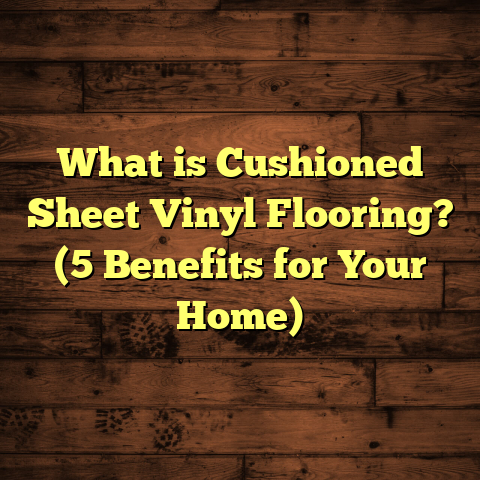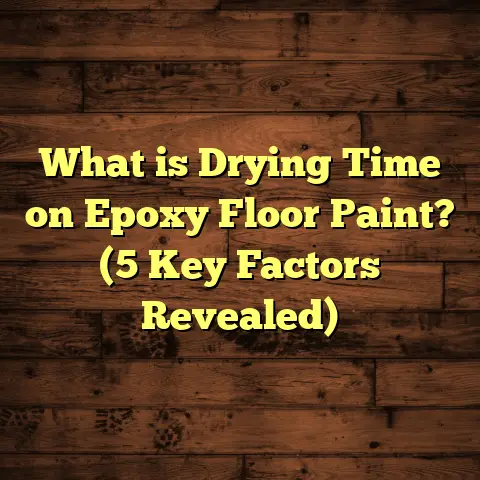What is Vinyl Plank Flooring vs. Laminate? (5 Key Comparisons!)
Starting with Affordability: Why I Care About It
When I first started working in flooring, affordability was always the question that came up first in nearly every conversation. People want their homes to look nice without spending a fortune. I get it – I’m the same way. Whether I’m helping a friend redo their kitchen or advising a client on a basement makeover, the budget is usually the number one priority.
Vinyl plank flooring and laminate flooring are two of the most affordable options out there that still deliver great style and performance. Over the years, I’ve installed both in various homes and seen firsthand how each performs in real-life situations. But here’s what I learned: price alone isn’t enough to make a good decision.
I remember working with Sarah, a young mom looking to update her kitchen floor on a tight budget. She was stuck between vinyl plank and laminate because both looked pretty similar in photos and were within her price range. After talking through her needs and lifestyle, I helped her understand why vinyl plank might be better for her kitchen, even if it was just a little more expensive upfront.
That experience reminded me that affordability isn’t just about the initial cost but also about long-term value. So let’s get into the details of vinyl plank vs. laminate flooring to help you make a smart choice you’ll feel good about for years.
What is Vinyl Plank Flooring and Laminate Flooring?
Before comparing them, it’s important to understand what these materials really are and where they come from.
Vinyl Plank Flooring
Vinyl plank flooring is a type of resilient flooring made primarily from synthetic materials—mostly PVC (polyvinyl chloride). It is designed to look like wood planks but is actually made up of several layers. Here’s how it breaks down:
- Wear Layer – The topmost layer protects against scratches, stains, and fading. It’s usually clear and very durable.
- Design Layer – This layer contains a high-resolution photographic image of wood grain or stone textures.
- Core Layer – Made from solid or composite vinyl providing strength and flexibility.
- Backing Layer – Adds stability and moisture resistance.
What makes vinyl plank unique is its waterproof nature because it’s plastic-based. That means it handles moisture well without warping or swelling.
Laminate Flooring
Laminate flooring is also engineered but uses a different construction method:
- Wear Layer – A tough, transparent layer that protects against scratches and stains.
- Design Layer – A photographic image layer that mimics wood or stone.
- Core Layer – High-density fiberboard (HDF) or medium-density fiberboard (MDF).
- Backing Layer – Provides stability and moisture resistance but not waterproof.
Laminate floors do a great job mimicking hardwood’s appearance but rely on fiberboard cores, which are more susceptible to moisture damage compared to vinyl.
1. Durability: Which Holds Up Better?
Durability is often the deciding factor for me when recommending flooring, especially for busy households or places prone to spills.
Vinyl Plank’s Strengths
Vinyl plank flooring stands out for its:
- Waterproof qualities: Because it’s made of plastic, water just sits on top instead of soaking in. This makes vinyl plank ideal for kitchens, bathrooms, laundry rooms, and basements.
- Scratch resistance: The wear layer is tough enough to handle pet claws, dropped utensils, or heavy foot traffic without showing wear.
- Flexibility: Slightly softer underfoot than laminate, vinyl plank can absorb impacts better without cracking.
I’ve been on jobs where heavy furniture was moved around on vinyl plank floors with no damage at all. For example, one family I worked with had two dogs who loved running through the house; their vinyl plank floors still looked brand new after several years.
Laminate Durability
Laminate flooring also offers strong scratch resistance due to its hard wear layer but has its limits:
- Water resistance: Most laminates are water-resistant but not waterproof. Prolonged exposure to moisture can cause swelling or warping.
- Impact resistance: Laminate can be brittle compared to vinyl plank, so sharp impacts might cause chipping or cracking.
- Wear over time: Laminates tend to show wear more visibly than vinyl plank after heavy use.
That said, laminate is still durable enough for many living spaces like bedrooms or dining rooms where moisture exposure isn’t an issue.
Data Snapshot on Durability
To give you numbers: according to a recent survey by the National Wood Flooring Association (NWFA), vinyl plank floors have a lifespan of 15-25 years under normal residential use, while laminate typically lasts 10-20 years. Scratch resistance testing showed vinyl planks scoring higher in abrasion resistance tests.
2. Appearance and Texture: How Real Does It Look?
People often pick flooring based on looks first—I get that! Both vinyl plank and laminate strive to replicate hardwood’s natural beauty.
Vinyl Plank Appearance
Vinyl plank uses advanced printing techniques that create detailed wood grain patterns with knots and color variations resembling real wood closely. Plus, many brands emboss textures on the surface that you can actually feel with your hand or foot.
For instance, I once installed luxury vinyl planks with hand-scraped textures and beveling that gave the floor depth and character like you’d find in custom hardwood floors.
Another advantage? Vinyl plank often comes in wider plank sizes (6-9 inches) compared to laminate (usually 4-7 inches), which can make rooms feel bigger and less “busy.”
Laminate Visuals
Laminate relies on high-quality photographic images placed under a clear wear layer. While some premium laminates look great in photos, they sometimes have a shinier finish that can appear less natural in certain lighting.
In my experience with clients:
- Cheaper laminates tend to look artificial due to uniformity.
- Mid-range laminates have decent wood grain detail but may lack texture.
- High-end laminates can be very convincing but generally don’t feel as warm as wood or vinyl plank underfoot.
Personal Experience
When Sarah was choosing between floors, she ran her hand over samples of both vinyl plank and laminate. She told me the vinyl felt warmer and more authentic, which mattered because she spends hours standing in her kitchen cooking.
3. Installation: How Easy Is It?
If you’re thinking about DIY installation or simply want to know what professionals do behind the scenes, here’s how these products compare.
Vinyl Plank Installation
Most modern vinyl planks feature click-lock installation systems that allow planks to snap together without glue or nails. Some even have self-adhesive backing for peel-and-stick applications.
Vinyl planks can be installed over existing hard surfaces like tile or concrete with minimal subfloor prep if those floors are level.
One thing I love about vinyl plank is how easy it is to cut with just a utility knife—no saw needed for many jobs—which makes small projects faster.
Laminate Installation
Laminate flooring also uses tongue-and-groove click-lock systems for floating installation (meaning no glue or nails). Installation is straightforward but usually requires a fine-toothed saw or miter saw for cutting planks precisely.
Laminate needs a flat subfloor free of bumps because unevenness can cause problems like gaps or squeaks down the line.
Tips From My Experience
Subfloor prep is probably the most overlooked step for both materials but is crucial for long-term success. A level floor makes installation smoother and prevents issues later.
Also, both floors require leaving expansion gaps around walls since they expand and contract slightly with temperature changes.
I use FloorTally during planning stages to calculate how many planks I’ll need including waste from cuts—this helps keep material costs tight and prevents delays caused by running out mid-job.
4. Cost: What Will It Really Set You Back?
Budgeting is always tricky because there are so many variables—from material quality to labor rates and project size.
Material Costs
Generally speaking:
- Vinyl plank flooring costs range from $2 to $5 per square foot depending on brand and quality.
- Laminate tends to be slightly cheaper, about $1.50 to $4 per square foot.
I’ve noticed premium vinyl planks with thicker wear layers and enhanced textures climb toward the higher end of that scale but offer better durability and appearance.
Installation Costs
Labor costs for installing both types are similar—usually $1.50 to $3 per square foot for professional installation depending on location and project complexity.
DIY installation can save labor costs but requires some skill and tools (especially for laminate).
Total Project Cost Example
Say you’re installing flooring in a 500-square-foot living room:
| Flooring Type | Material Cost | Installation Cost | Total Cost |
|---|---|---|---|
| Vinyl Plank | $3.50/sq ft | $2.00/sq ft | $2,750 |
| Laminate | $2.50/sq ft | $2.00/sq ft | $2,250 |
I use FloorTally frequently to get exact estimates based on local prices including labor rates, taxes, delivery fees, and waste factors—this saves me time and money by avoiding surprises during purchase or installation.
5. Maintenance: How Much Effort Is Required?
Low maintenance is one of the biggest selling points for both vinyl plank and laminate flooring compared to wood or carpet.
Vinyl Plank Maintenance
Vinyl plank floors require sweeping or vacuuming regularly to remove dirt and grit that could scratch surfaces over time. Mopping occasionally with water or gentle cleaners keeps them looking fresh. Because they’re waterproof, spills don’t need immediate drying but it’s good practice anyway.
In fact, one family I know has had their vinyl plank kitchen floor for over a decade with minimal maintenance—just regular cleaning—and it looks almost new.
Laminate Care
Laminate needs similar routine cleaning but you have to be quicker about wiping spills because standing water can damage the fiberboard core underneath.
Avoid soaking laminate floors with water during mopping; use damp mops instead.
Also, laminate floors benefit from protective pads under chairs and furniture legs to prevent scratches.
Long-Term Care Tips
- Use rugs in high-traffic areas to reduce wear.
- Avoid harsh chemicals or abrasive scrubbers.
- Keep pet nails trimmed.
- Regularly inspect floors for damage early before problems worsen.
Extra Insights: Environmental Impact & Sustainability
People ask me about eco-friendly flooring options too—here’s what I found:
Vinyl Plank
- Made mostly from PVC plastic which isn’t biodegradable.
- Some manufacturers now use recycled materials in cores or backing.
- Durable lifespan reduces need for replacement which can be more sustainable long-term.
- Off-gassing of VOCs (volatile organic compounds) can be a concern but many brands now meet strict indoor air quality standards (look for FloorScore certification).
Laminate
- Uses wood fiber cores which come from trees—often sourced sustainably but still involves deforestation concerns.
- Some laminates contain formaldehyde resins; newer products have lower emissions.
- Recyclability depends on product design; many laminates are harder to recycle due to composite layers.
If sustainability matters deeply to you, I recommend checking product certifications like GREENGUARD or FloorScore before buying either type of floor.
Unique Case Study From My Work
A couple years ago, I helped renovate a vacation rental property near a lake. The owners wanted floors that could handle wet shoes, sand tracked inside, and lots of foot traffic from guests without breaking their renovation budget.
We chose luxury vinyl plank flooring because:
- It’s waterproof—ideal for wet entryways.
- Durable surface stood up well to heavy use.
- Warm feel made guests comfortable.
- Installation was quick so the property could open sooner.
After two years of heavy rental use with hundreds of visitors yearly, the floors still look fantastic with minimal maintenance required—proof that vinyl plank holds up well in demanding environments.
Final Thoughts From Me
So now you’ve got plenty of info based on real projects, data, and personal stories about vinyl plank vs. laminate flooring:
- Vinyl plank wins hands down if you want waterproof durability and realistic texture.
- Laminate works fine in dry spaces where cost savings matter most.
- Both are easy enough for DIYers but prep matters.
- Budget-wise they’re close—planning tools like FloorTally help avoid surprises.
- Maintenance is simple if you keep up with cleaning and protect your floors properly.
If you want my honest opinion: for kitchens, bathrooms, mudrooms, or basements—I’d go with vinyl plank every time. For bedrooms or formal living rooms where moisture isn’t an issue—laminate gives you good value if you want something affordable that looks nice too.
Got questions? Need help figuring out what fits your home best? Just reach out—I’m happy to share what I know!





